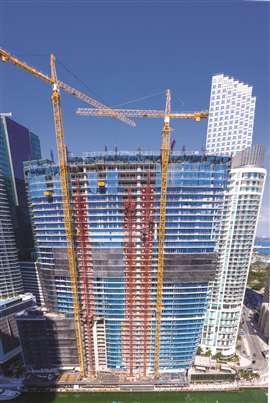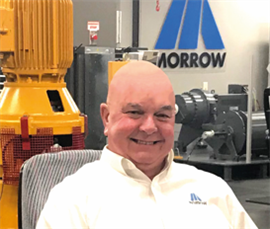An update on the North American tower crane market
05 June 2023
As chairman of the Tower Crane Committee for SC&RA, I make it a point at each of the three meetings during the year to touch base on the current trends and regulations, along with changing laws that affect the industry. The tower crane industry is ever-evolving, not only in compliance matters, but jobsite logistics, contract terms and an ever-growing concern with regards to financing and completion of projects in the pipeline that have not yet been funded. Challenges are ever increasing in the way tower crane companies evolve and adapt to regulations, contract terms and competition.
 G&E Florida Contracting is constructing the 830 Brickell project in Miami, FL. Working on the job, Morrow Equipment has two each Liebherr 316 EC-H/12 Litronic tower cranes with a final hook height of just under 900 feet.
G&E Florida Contracting is constructing the 830 Brickell project in Miami, FL. Working on the job, Morrow Equipment has two each Liebherr 316 EC-H/12 Litronic tower cranes with a final hook height of just under 900 feet.
The best indicator I have found to see where the construction industry is going is to follow the Architectural Billing Index (ABI). The ABI follows, month by month, the billings and new contracts in the architectural market. The base line for this report is over and under 50, meaning anything over 50 is growth, and anything under is retraction. In March of 2023 (latest post prior to the writing of this article) the index increased for the first time in five months. While billings increased from 48 in February to 50.4 in March, new contracts decreased, but at a slower pace (from 52 to 48). Pressure from rising interest rates is reported as the main cause. Despite this, the outlook is still good for long-term construction. In comparison, in March of 2022 new design contracts were at 59, an 11-point drop to March 2023. In the sectors, Commercial stood at 49.7, Industrial at 48.8 and Residential at 44.2. You can check out the ABI on their website, and there is additional data available, including trends and regional information.
Air rights challenges
Air rights is another hot topic the tower crane industry has faced, as owners of properties adjacent to new construction push back on having a crane jib or boom swinging over their property. Some jurisdictions have addressed these issues, but there is a lack of definitive case law in many jurisdictions. Many times, the solution is for the owner of the developing property to pay the owner of the existing property a fee to use their air space. But is this the best route? Probably not.
“Uius est solum, eius est usque ad coelum et ad inferos” (whoever’s is the soil, it is theirs all the way to Heaven and all the way to Hell). As the name describes, the principle is that a person who owns a particular piece of land owns everything above and below it as well. California applies a “reasonable use” standard. Hinman v. Pacific Air Transport, 84 F.2d 755 (9th Cir. 1936). In the context of tower cranes, developers need to consider the property over which the crane would swing. For example, if a crane is hundreds of feet in the air and hangs over a two-story building or a parking lot, the presence of the crane likely does not impede the existing use of the property. If the crane hangs over a public park or open space, the presence of shadows on the property may technically interfere with the use of the park by depriving the park of sunlight.
However, the amount of harm caused by shadows that only cover a small portion of the park would be minimal. Nevertheless, the best practice may be to avoid casting shadows during the times of day when people would use the park, such as the lunch hour. Finally, even if a tower crane traverses airspace over a high-rise building, unless there is some use made of the airspace above the building, or the crane interferes with light, the high-rise owner might not have any harm on which it could sensibly seek an injunction or damages in a California court.
The risk of prolonged litigation forces many owners to settle and pay for the air rights to complete their project on schedule. In Portland, OR, Nordstrom sued the developer constructing a building next door where the jib would swing over its store in 2011. This litigation delayed the project nearly two years, and the developer ended up removing the hammerhead tower crane and replacing it with a luffing boom crane.
Proactive approach
Hawaii took a proactive approach recently, enacting House Bill 3555, which defines air rights in its civil trespass code, which says that “A person commits the offense of civil trespass onto real property if the person intentionally or knowingly enters or remains unlawfully in or upon premises without prior authorization or invitation by the owner; provided that conduct shall not constitute trespass if it occurs in the airspace above the premises and the conduct; does not interfere with the owner’s actual use of the premises; or is directly related to the construction of affordable housing, as that term is defined in section 201H-57. A claim of mistaken entry upon the premises or a claim of ignorance as to the location of the boundary line of the premises shall not constitute a defense to civil trespass. No cause of action may be brought by a property owner based upon a claim of trespass into airspace when the conduct falls within one of the exceptions identified.”
I’m sure there will eventually be challenges to this new law, but time will tell. The best approach any owner can take is to address this issue well before construction starts. Tower crane companies can be a source of information up front once the issue of an air space incursion is going to take place.
Contract conundrum
One of the biggest challenges over the past few years is contract terms. Many contractors are pushing onto tower crane rental companies their long form or short form contracts. These are really designed for subcontractors that add value to the building, such as concrete, electrical or plumbing subs. Shoehorning in rental agreements into these contracts is very difficult. Most of the terms in these contracts do not fit the rental of a tower crane, whether bare rental or a full turn-key package. And if you don’t have good solid counsel that truly understands the terms, and how to negotiate the ones that can be devastating to your company, you are facing a possible catastrophic financial loss. Terms like paid-when-paid, retention, indemnity (particularly where you defend the contractor for their negligence) and the real nuclear one, liquidated damages. Additional insured, completed operations coverage, and accepting a direct flow down from the prime contract are other terms you need to be very cautious of. I’m not an attorney, but I have great in-house counsel who is and understands these terms. We work together to minimize our risk, and still be able to come to mutually acceptable terms with our customers. I strongly advise all, no matter how small your operation is, to seek counsel and truly understand what you are signing and agreeing to. One bad clause in a contract could literally destroy your company financially. These negotiations with contractors can be lengthy and arduous but are well worth the effort.
The construction activity across the board is still strong right now, but there are some cracks in the dam visible. Interest rate hikes and some uncertainty in the economy have some on edge. I’m the ultimate optimist, and believe the dip will be shallow (when it comes) and construction will continue. Be smart in your decisions and know where the land mines lay.
THE AUTHOR

Peter Juhren is President and COO of Morrow Equipment, and is a Member of the B30 main committee, B30.3 Tower Crane Committee and Chairman of the SC&RA Tower Crane Committee.




